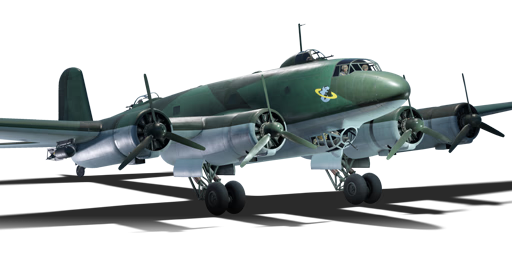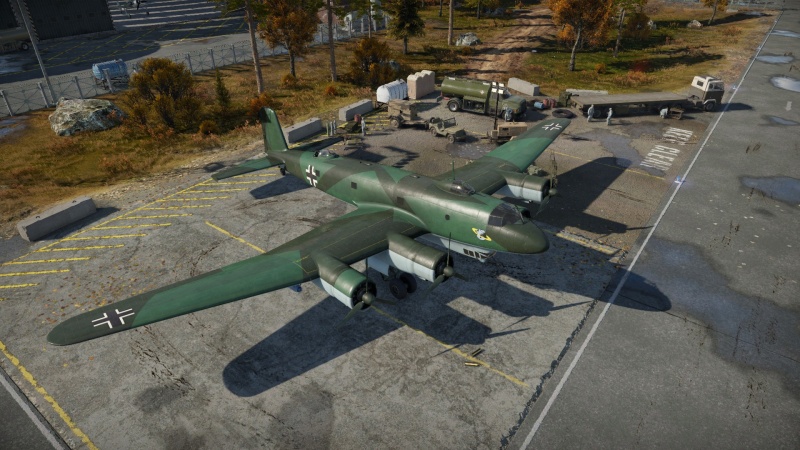Difference between revisions of "Fw 200 C-1"
El_juanma45 (talk | contribs) m (→Pros and cons) (Tag: Visual edit) |
m (→Pros and cons) (Tag: Visual edit) |
||
| Line 139: | Line 139: | ||
'''Pros:''' | '''Pros:''' | ||
| − | * | + | * Large bomb payloads |
| − | * | + | * Large fuel capacity |
| − | |||
'''Cons:''' | '''Cons:''' | ||
| − | * Very slow | + | * Very slow top speed |
| − | * | + | * Ineffective defensive weaponry |
| − | * | + | * Slow acceleration |
| − | * | + | * Weak airframe gets damaged easily |
| − | |||
== History == | == History == | ||
Revision as of 00:02, 28 May 2022
Contents
Description
The Fw 200 C-1 is a rank II German bomber with a battle rating of 2.3 (AB), 2.0 (RB), and 3.0 (SB). It was introduced in Update 1.47 "Big Guns".
The Focke-Wulf Fw 200 C-1 is a long-range maritime patrol bomber. It is optimised for bombing stationary targets, such as bases and pillboxes, from medium to high altitudes.
General info
Flight performance
The Condor handles, as all long range bombers, like a flying brick. Its turns are cumbersome and it is best to climb gradually, slowly gathering speed. Once at an altitude of 4,000-5,000 metres it is best to fly straight and level to the target. Always keep a significant distance between yourself and any enemies. If you miss a base always fly for a short distance before turning to have another go, as the large turning circle could cause you to miss again. Once you have expended all your bombs, reduce throttle to 0% and gradually descend towards your base. Keep an eye on your speed so you don't rip your wings off. Despite its size the Condor is surprisingly easy to land, but make sure you aren't going too fast and you have enough runway.
| Characteristics | Max Speed (km/h at 1,500 m) |
Max altitude (metres) |
Turn time (seconds) |
Rate of climb (metres/second) |
Take-off run (metres) | |||
|---|---|---|---|---|---|---|---|---|
| AB | RB | AB | RB | AB | RB | |||
| Stock | 363 | 350 | 6000 | 30.7 | 31.3 | 1.7 | 1.7 | 700 |
| Upgraded | 396 | 378 | 29.3 | 30 | 6.9 | 4.0 | ||
Details
| Features | ||||
|---|---|---|---|---|
| Combat flaps | Take-off flaps | Landing flaps | Air brakes | Arrestor gear |
| ✓ | ✓ | ✓ | X | X |
| Limits | ||||||
|---|---|---|---|---|---|---|
| Wings (km/h) | Gear (km/h) | Flaps (km/h) | Max Static G | |||
| Combat | Take-off | Landing | + | - | ||
| 0 | 200 | 333 | 311 | 200 | ~2 | ~2 |
| Optimal velocities (km/h) | |||
|---|---|---|---|
| Ailerons | Rudder | Elevators | Radiator |
| < 260 | < 230 | < 260 | > 290 |
Survivability and armour
- 8 mm steel - pilots seat
- Fuel tanks located between wing root and out-most engine, as well as taking up most of the fuselage
Modifications and economy
First, obtain the bomb upgrade (ITC PVC/II). This will allow the installation of 6 x 500 kg bombs, the best payload for base bombing, since it allows the destruction of two bases in one pass. There will be no need to hurry with the second upgrade. The 2 x 1000 kg + 2 x 500 kg loadout is only ideal for taking out airfields or carriers. Flight performance upgrades come next in the priority list, as the aircraft is heavy and slow. The ammo belts are of a lesser priority, since the upgraded belts don't make a considerable difference.
Armaments
Suspended armament
The Fw 200 C-1 can be outfitted with the following ordnance:
- 6 x 250 kg SC250JA bombs (1,500 kg total)
- 6 x 500 kg SC500K bombs (3,000 kg total)
- 2 x 1,000 kg SC1000L2 bombs (2,000 kg total)
- 2 x 1,000 kg SC1000L2 bombs + 4 x 250 kg SC250JA bombs (3,000 kg total)
- 2 x 1,000 kg SC1000L2 bombs + 2 x 500 kg SC500K bombs (3,000 kg total)
Defensive armament
The Fw 200 C-1 is defended by:
- 1 x 7.92 mm MG 15 machine gun, nose turret (2,250 rpg)
- 1 x 7.92 mm MG 15 machine gun, chin turret (1,500 rpg)
- 1 x 7.92 mm MG 15 machine gun, dorsal turret (1,125 rpg)
- 1 x 7.92 mm MG 15 machine gun, ventral turret (1,125 rpg)
Usage in battles
The graceful looks of the Condor belie a very vulnerable and slow aircraft. Essentially a converted civilian airliner, the Condor has a very weak airframe and large fuel tanks scattered throughout the aircraft, making it vulnerable to even rifle-calibre bullets.
To make things worse, the Condor is rather underpowered, despite having four engines. It is outrun by biplane fighters and has a very poor climb rate. The defensive armament is also very poor, consisting of only 7.92 mm machine guns with blind spots in the coverage. If caught by enemy fighters, it has virtually no chance of survival.
The one redeeming factor of the Condor is its massive payload of 3,000 kg bombs. It is one of the heaviest bomb loads carried by any non-premium German bomber, except for the Dornier Do 217 series, the Messerschmitt Me 264, and the He 177. If the Condor can penetrate enemy air defences, it is capable of inflicting massive damage to bases.
Manual Engine Control
| MEC elements | ||||||
|---|---|---|---|---|---|---|
| Mixer | Pitch | Radiator | Supercharger | Turbocharger | ||
| Oil | Water | Type | ||||
| Not controllable | Controllable Not auto controlled |
Not controllable Not auto controlled |
Controllable Not auto controlled |
Combined | Not controllable 1 gear |
Auto controlled |
Pros and cons
Pros:
- Large bomb payloads
- Large fuel capacity
Cons:
- Very slow top speed
- Ineffective defensive weaponry
- Slow acceleration
- Weak airframe gets damaged easily
History
The Focke-Wulf Fw 200 Condor is best remembered as a long-range reconnaissance aircraft that searched for Allied convoys over the North Atlantic during World War II. Its mission was to either attack the convoys directly with bombs or communicate their location to the packs of German U-boats below. The Condor started as a transatlantic airliner that first flew in July of 1937. By September of 1939, over 250 Condors had entered military service. The Condor spawned many sub-variants that included different armament, radar, missile carriage and guidance systems, and transport. A handful of these aircraft were used for VIP transports.
Media
- Skins
- Videos
See also
Links to the articles on the War Thunder Wiki that you think will be useful for the reader, for example:
- reference to the series of the aircraft;
- links to approximate analogues of other nations and research trees.
External links
Paste links to sources and external resources, such as:
- topic on the official game forum;
- other literature.
| Focke-Wulf Aircraft Corporation (Focke-Wulf Flugzeugbau Aktiengesellschaft) | |
|---|---|
| Fighters | Fw 190 A-1 · Fw 190 A-4 · Fw 190 A-5 · Fw 190 A-5/U2 · Fw 190 A-5/U12 · Fw 190 A-5/U14 · Fw 190 A-8 |
| Fw 190 C | |
| Fw 190 D-9 · Fw 190 D-12 · Fw 190 D-13 | |
| Fw 190 F-8 | |
| Ta 152 C-3* · Ta 152 H-1* · Ta 154 A-1* | |
| Bombers | Fw 189 A-1 · Fw 200 C-1 |
| Export | ▅Fw 190 A-5 |
| Captured | ▃Fw 190 A-8 · ▂Fw 190 D-9 |
| * In 1944, the Germany Air Ministry changed new fighter aircraft designation to that of the chief designer. Kurt Tank was the chief designer at Focke-Wulf and later aircraft he designed were given the prefix of Ta. | |
| Germany bombers | |
|---|---|
| Arado | Ar 196 A-3 |
| Blohm & Voss | BV 138 C-1 · BV 238 |
| Dornier | Do 17 E-1 · Do 17 Z-2 · Do 217 E-2 · Do 217 E-4 · Do 217 K-1 · Do 217 M-1 |
| Focke-Wulf | Fw 189 A-1 · Fw 200 C-1 |
| Henschel | Hs 123 A-1 |
| Heinkel | He 111 H-3 · He 111 H-6 · He 111 H-16 · He 115 C-1 · He 177 A-3 · He 177 A-5 |
| Junkers | Ju 87 B-2 · Ju 87 R-2 · Ju 87 R-2 Libya · Ju 87 D-3 · Ju 87 D-5 · Ju 88 A-1 · Ju 88 A-4 · Ju 188 A-2 · Ju 288 C |
| Messerschmitt | Me 264 |
| Savoia-Marchetti | ▀S.M.79 serie 1 · ▀S.M.79 B · ▀S.M.79 serie 4 · ▀S.M.79 serie 8 |
| ▀S.M.79 AS · ▀S.M.79 bis/N · ▀S.M.79 bis/T.M | |
| Trophies | ▀Wellington Mk Ic |





